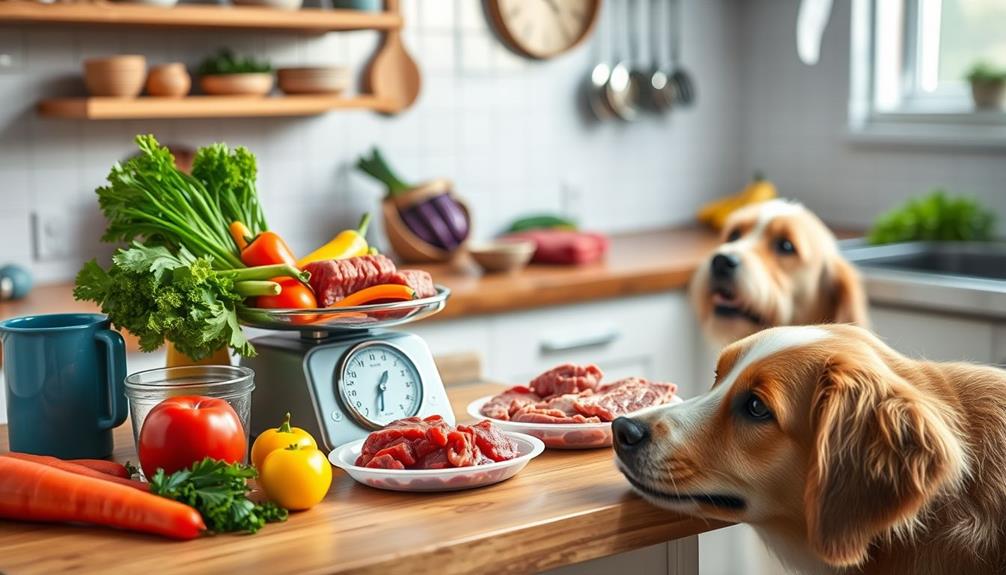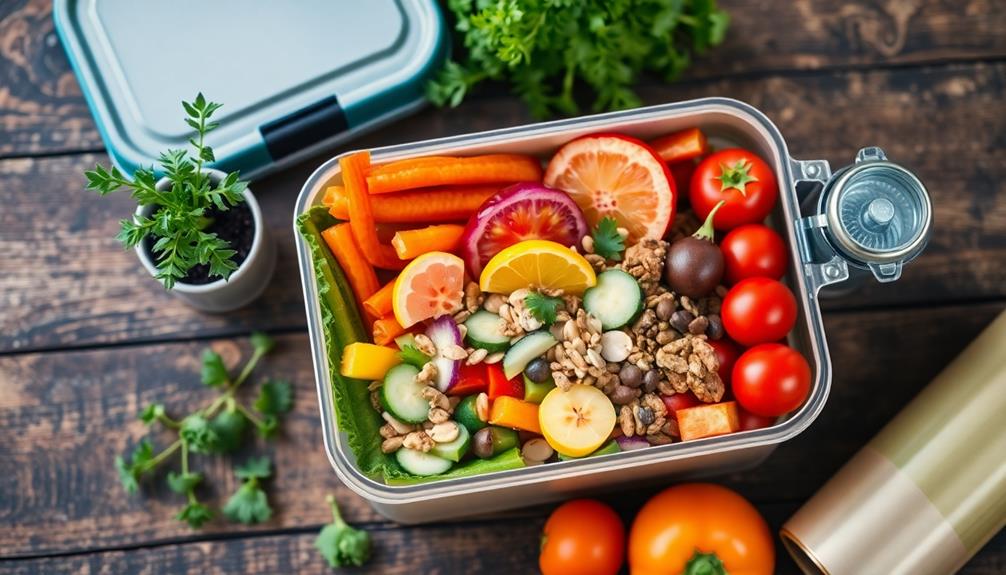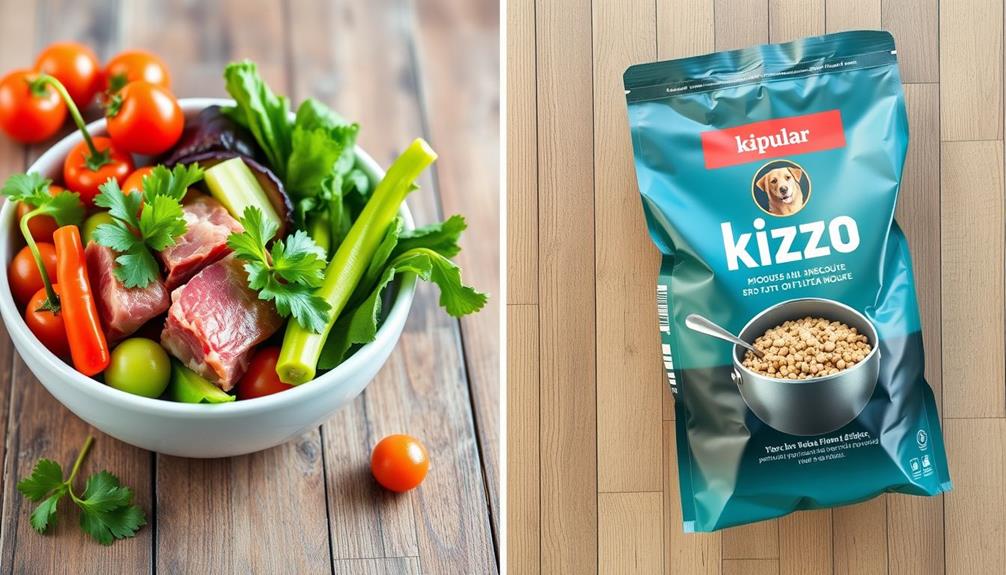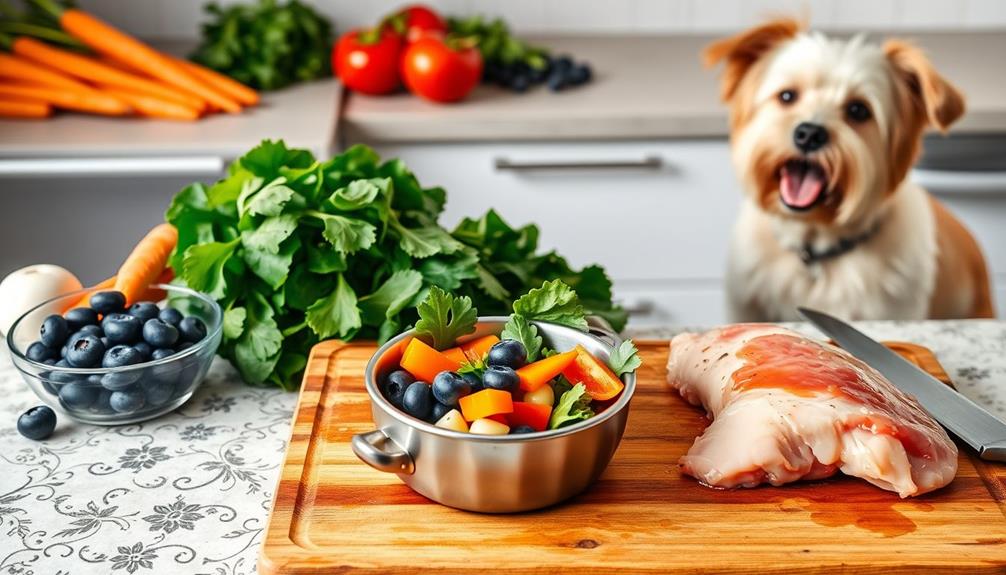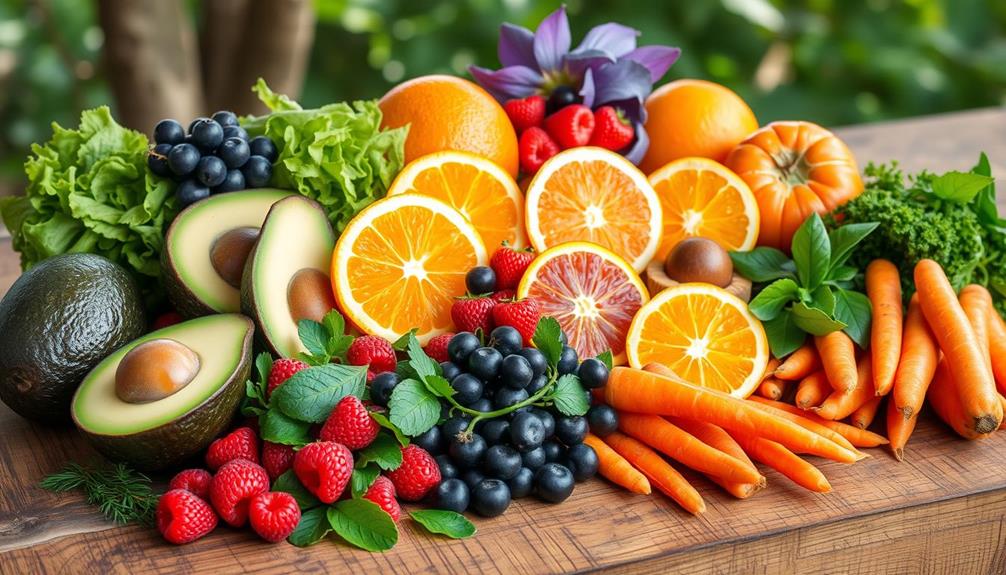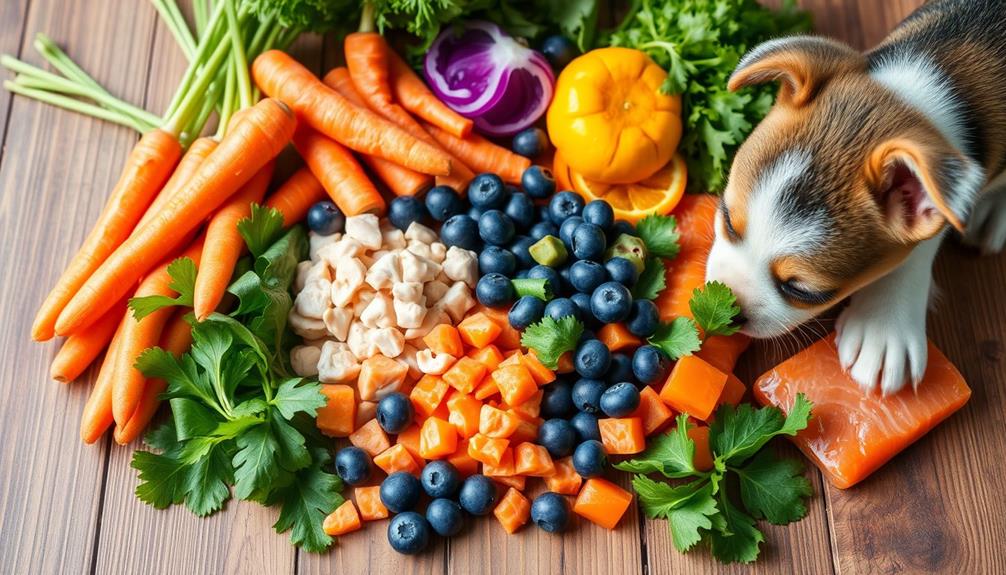To determine how many ounces of raw food to feed your dog, start by calculating 2-4% of their body weight daily. For example, if your dog weighs 50 pounds, they need about 1.5 to 2 pounds, which is 24 to 32 ounces. Active dogs may need up to 5% of their body weight, while less active ones can stick to the lower end. Don't forget to split their meals into two servings to aid digestion. Adjust portions as needed based on your dog's activity level and health. There's much more to take into account for a balanced raw diet, so keep exploring!
Key Takeaways
- Feed your dog 2-3% of their body weight in raw food daily; for example, a 50-pound dog needs approximately 1-1.5 pounds (16-24 ounces).
- Active dogs may require 3-5% of their body weight, while less active dogs should stick to 2%.
- Split daily portions into two meals to aid digestion and prevent bloat.
- Monitor your dog's weight regularly to adjust feeding amounts as needed.
- Use a raw food calculator to tailor the portion size based on your dog's weight and activity level.
Understanding Raw Dog Food
Understanding raw dog food is vital for any pet owner considering this dietary approach. A raw food diet typically consists of uncooked muscle meat, organ meat, and bones, often complemented with fruits and vegetables. This combination aligns with your dog's natural dietary needs and guarantees a balanced diet that meets their nutritional needs.
Additionally, incorporating a variety of ingredients can provide beneficial nutrients and support overall health.
When you're planning to feed raw dog food, it's essential to include muscle meat, organ meat, and bones to prevent deficiencies and promote peak health. Dogs possess strong stomach acid and digestive enzymes, enabling them to safely digest raw meat more effectively than humans can.
To guarantee your dog receives complete nutrition, look for products that meet AAFCO recommendations, such as those offered by companies like We Feed Raw. They provide correctly proportioned raw food options, making it easier for you to maintain your dog's health.
Factors Influencing Feeding Amount
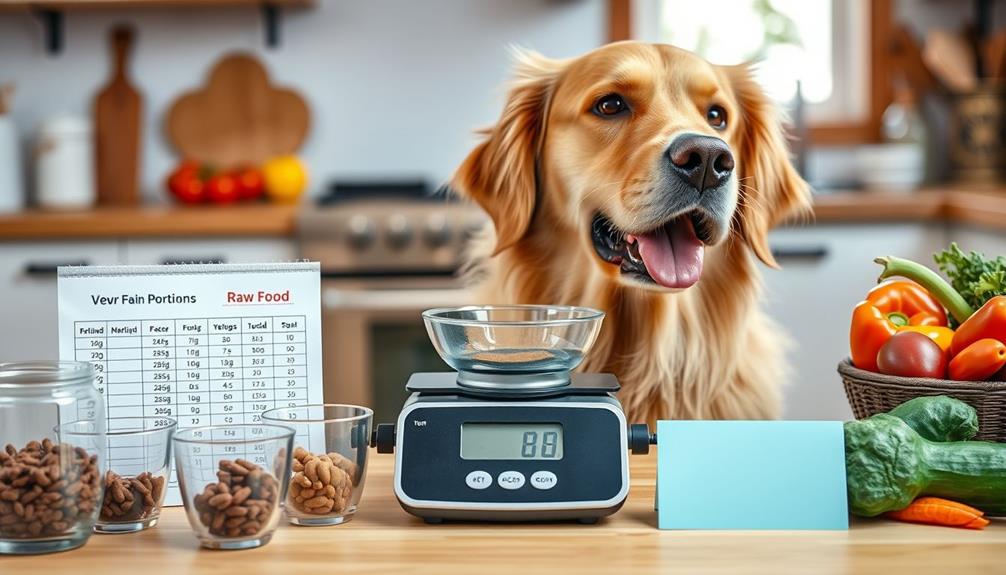
When feeding your dog a raw food diet, several factors influence the amount you'll need to provide. To guarantee you're giving the right feeding amount, consider the following:
1. Body Weight: A general guideline suggests feeding dogs 2-4% of their body weight daily. Smaller dogs often require a higher percentage, around 5-6% for those up to 5 lbs.
It's important to monitor their weight regularly to adjust feeding amounts as needed, as proper diet guidelines can help maintain their health.
2. Activity Level: Active or underweight dogs may need closer to 3-5% of their body weight, while senior or inactive dogs might require less than 2%.
3. Age: Puppies often need 2-3 times the food of adult dogs of the same weight.
Adjust the feeding frequency according to their growth stage.
4. Metabolic Rate: Factors like breed and environmental temperature can affect your dog's metabolic rate, impacting how much they should eat.
Daily Feeding Guidelines
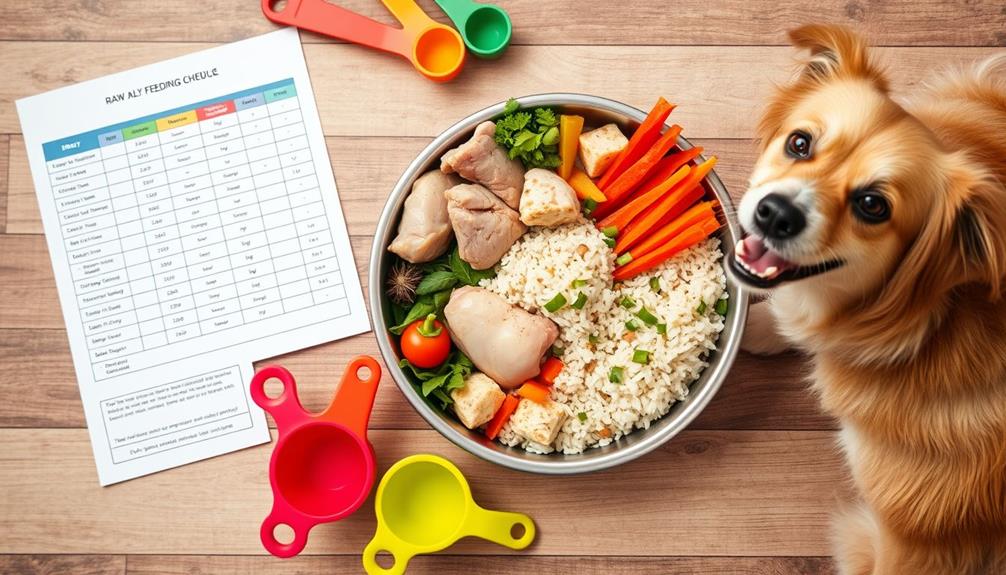
When it comes to daily feeding guidelines for your dog, you'll want to take into account their weight, activity level, and overall health.
Generally, feeding 2-3% of their body weight in raw food is a solid starting point. Incorporating healthy dog snacks can also promote overall wellness and keep your pet satisfied.
Additionally, splitting their daily portion into two meals can help with digestion and prevent issues like bloat.
Daily Portion Recommendations
Feeding your dog the right portion of raw food is essential for their health and well-being. To guarantee ideal digestion and overall health, follow these daily portion recommendations:
Dogs with specific health considerations may also benefit from tailored feeding plans that take into account their unique needs and conditions, such as age and activity level. Always remember to consult with your veterinarian for financial assistance options related to pet healthcare, especially as they age.
- Calculate Daily Portion: For most dogs, feed them 2-3% of their body weight in raw food daily. For example, a 50-pound dog needs about 1 to 1.5 pounds daily, split into two meals.
- Adjust for Activity Level: Active dogs may require 3-5% of their body weight, while less active dogs should stick closer to 2%. This guarantees they get the energy they need without overfeeding.
- Consider Size Differences: Smaller dogs often need a higher percentage of their body weight. A 10-pound dog might need around 3.2 to 4 ounces per meal.
- Monitor Individual Conditions: Always adjust food quantities based on your individual dog's condition and health considerations. If your dog has specific needs, consult your vet for tailored advice.
Feeding Frequency Suggestions
Establishing a consistent feeding frequency is key to maintaining your dog's health and well-being. For adult dogs, it's generally recommended to feed them twice a day, dividing their daily raw food amount into two meals. This approach aids digestion and helps prevent bloat.
Additionally, guaranteeing your dog receives the right nutrition is essential for overall health, especially when considering their dietary needs for peak performance and energy levels during activities recommendations for usage.
When deciding how much raw food to feed, consider the feeding frequency suggestions of 2-4% of their body weight, which can vary based on their activity level. Sedentary dogs may only require around 2% of their body weight daily, while more active dogs might need up to 5%.
Smaller dogs, especially those under 10 pounds, often require a higher percentage, typically around 4-6%.
While feeding your dog, pay attention to their body condition. Monitoring your dog's body condition is essential, as it allows you to adjust the feeding frequency or amount as needed.
If your dog seems to be gaining or losing weight, you might need to tweak their meals accordingly. By following these guidelines, you'll help guarantee your furry friend stays healthy and happy.
Adjusting for Activity Level
Adjusting your dog's diet according to their activity level is essential for ensuring they receive the right amount of nutrition. Different activity levels require specific daily raw food amounts based on their body weight.
For instance, if your dog suffers from dental issues, consider incorporating essential oils like clove oil into their routine, as they're known for their analgesic properties.
Here's a quick guide:
- Active Dogs: Feed about 3-5% of their body weight. For example, a 50-pound active dog needs 1.5 to 2.5 pounds of raw food daily.
- Normal Activity: For dogs with moderate activity, you should provide around 2.5-3% of their body weight.
- Sedentary Lifestyle: Dogs that are less active or overweight typically need only 2% of their body weight, like a 25-pound dog needing about 0.5 pounds of food.
- Adjustments: Regularly monitor your dog's body condition and adjust their feeding amounts as necessary to maintain a healthy weight.
To calculate daily raw food amounts, multiply your dog's weight by the appropriate percentage: 0.02 for inactive, 0.025 for normal, and 0.03 for active.
Keeping a close eye on your dog's activity level and body weight will help you make the right adjustments to their diet.
Calculating Raw Food Portions
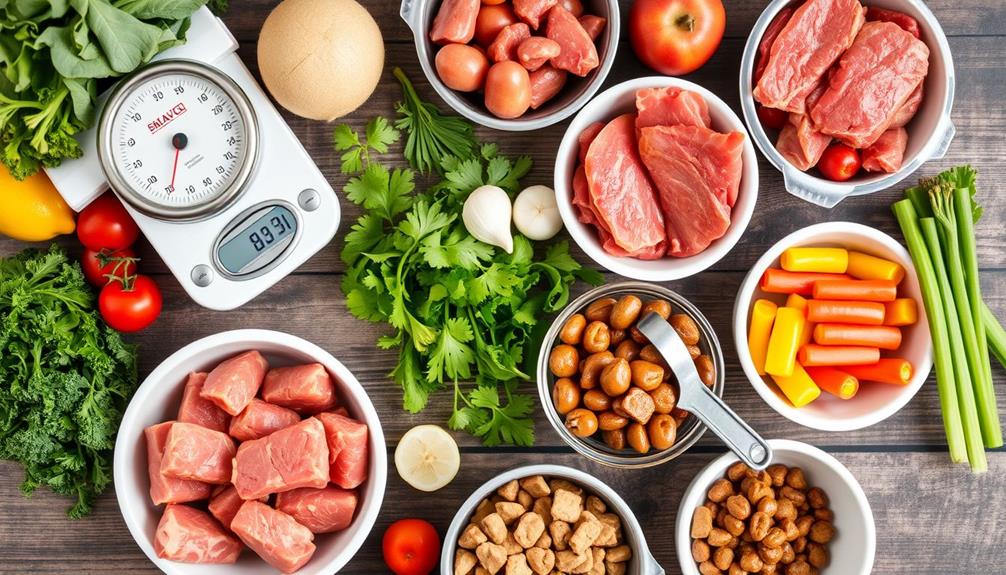
When determining how much raw food your dog needs, it's vital to take into account their body weight and activity level. To calculate the appropriate amount, follow the general feeding guidelines: feed 2-3% of your dog's body weight daily, split into two meals.
For example, if your dog weighs 50 pounds, they'll require about 1 to 1.5 pounds of raw food daily, translating to roughly 8 to 12 ounces per meal. Understanding your dog's nutritional needs is essential for their overall health and well-being; as a result, a well-planned budget can help allocate funds for quality dog food and veterinary care, which are vital for maintaining your pet's health.
For more insights, consider common financial terms.
Keep in mind that active dogs or those that are underweight may need closer to 3-5% of their body weight in raw food. On the other hand, overweight or less active dogs should stick to around 2% of their body weight daily. Smaller dogs typically need a higher percentage; a dog weighing up to 5 pounds may require 5-6% of its body weight in raw food.
Using a raw food calculator can simplify this process. By entering your dog's weight and activity level, you can quickly determine the appropriate daily intake in ounces. This will guarantee your furry friend receives the right nutrition to thrive.
Feeding Recommendations for Puppies
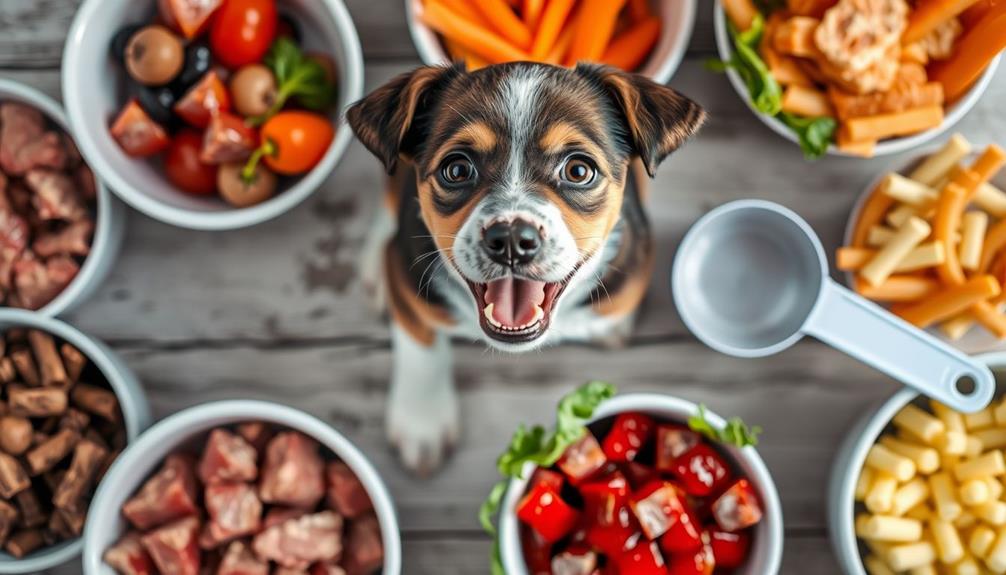
Feeding your puppy properly is essential for their growth and development. Puppies have unique nutritional demands and need more food than adult dogs of the same weight. It's also important to guarantee that any food you choose is free from harmful additives and allergens, similar to the care taken when selecting essential oils for skin conditions.
Here are some key feeding recommendations:
- Meal Frequency: Very young puppies should eat 3-4 times a day. As they grow older, you can shift to twice-daily feedings.
- Portion Size: Start with about 2-3% of their ideal adult weight or 10% of their current weight. Begin with 1-2 recipes and gradually increase variety.
- Monitoring Growth: Keep a close eye on your puppy's growth. Adjust the amount of food based on their age, weight, and activity level to guarantee they're thriving.
- Supplements: Consider adding beneficial supplements like fish oil, kefir, apple cider vinegar, and pre/probiotics to support their overall health.
Transitioning to a Raw Diet
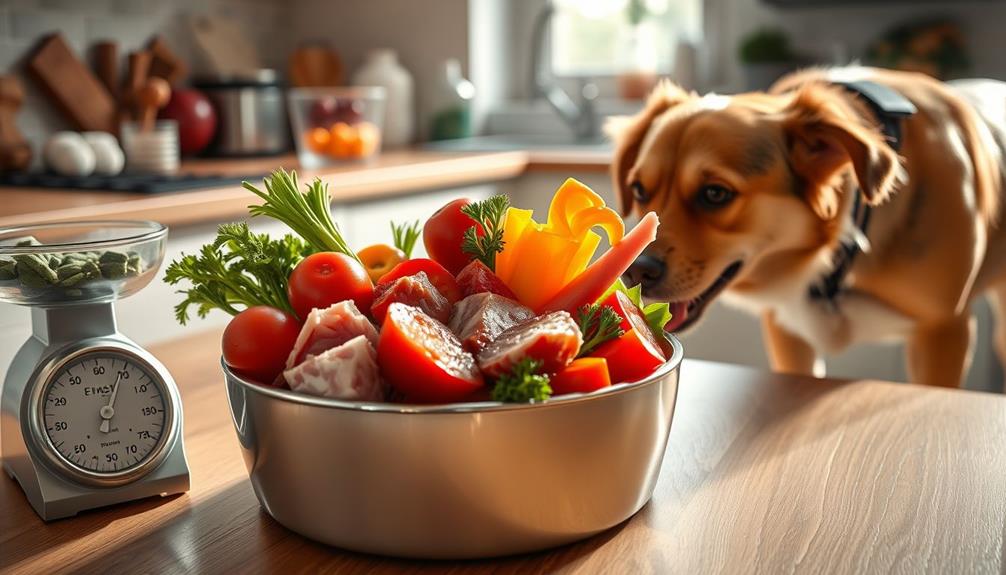
When you're shifting your dog to a raw diet, it's essential to do it gradually to avoid digestive issues.
A balanced diet rich in essential nutrients is important for your dog's overall health and well-being, so consider incorporating elements from effective strategies for weight loss to make sure your dog maintains a healthy weight.
Start with a mix of 25% raw food and monitor your dog's health closely, paying attention to any changes in weight or digestion.
This careful approach helps make certain your dog adjusts well and maintains a healthy weight throughout the process.
Gradual Transition Process
Changing your dog to a raw diet requires a careful approach to avoid digestive upset. A gradual shift is essential for your dog's digestive system to adjust properly, similar to the way imagination mobilizes mental potential for personal growth.
Here's how to make the switch smoothly:
- Days 1-3: Start with 25% raw food mixed with 75% of your dog's current diet. This initial mix allows their body to adapt.
- Days 4-6: Increase to a 50/50 ratio of raw food and old diet. Monitor your dog closely during this phase for any signs of discomfort.
- Days 7-9: Shift to 75% raw food and 25% of the old diet. Keep an eye on their weight and make sure they're tolerating the new diet well.
- Day 10: Aim for a full shift to raw food. Feed about 2-3% of your dog's body weight in total daily food.
During this shift, it's normal for dogs to lose some weight, but it shouldn't exceed 1-2% of their body weight per week.
Adjust the percentages as needed, keeping your dog's health and comfort in mind throughout the process.
Monitoring Digestive Health
As your dog adjusts to a raw diet, keeping a close watch on their digestive health becomes paramount. During this changeover, it's normal for some dogs to experience slight weight loss, typically around 1-2% of their body weight per week due to initial water loss.
Monitoring stool quality is key; smaller, firmer stools indicate better digestion and nutrient absorption as your dog adapts to the new diet.
Start with a gradual introduction, mixing 25% raw food with 75% of their current diet to minimize digestive upset. Watch for any signs of discomfort, such as diarrhea or vomiting, which may suggest that you need to slow down the changeover process.
If these issues arise, consider reaching out to a veterinarian for guidance.
Your dog's digestive health is essential during this period, and their response to the raw diet will inform how you proceed. Regularly evaluate their stool quality and overall well-being to guarantee they're adapting smoothly.
Weight Management Considerations
Shifting to a raw diet is an important phase that requires careful attention to your dog's weight management.
During this changeover, you'll likely notice some initial weight loss, mainly from water weight. To guarantee health stability, follow these key guidelines:
- Gradual Introduction: Start with a mix of 25% raw food and 75% of their current diet for the first three days. This helps minimize digestive issues.
- Monitor Weight Loss: Aim for a gradual weight loss of no more than 1-2% of your dog's body weight per week. This keeps their health stable.
- Adjust Feeding Amounts: Keep an eye on your dog's response to the raw diet. Be prepared to adjust feeding amounts to maintain an ideal weight.
- Vet Collaboration: If your dog has pre-existing health conditions, work closely with your vet during this changeover to guarantee a smooth process.
Raw Food Calculator Usage

Using a raw food calculator can simplify the process of determining how much raw food to feed your dog. Start by inputting your dog's weight in pounds, which will give you baseline feeding recommendations tailored to their individual needs.
The calculator typically allows you to choose the percentage of their total diet that consists of raw food, ranging from 10% to 100%.
For instance, an active 50-pound dog may require around 1.5 to 2 pounds of raw food daily, depending on their activity level. It's important to adjust these amounts based on considerations like age, health, and specific dietary requirements.
Remember, the calculator serves as a guideline rather than a definitive rule.
As you implement these recommendations, keep a close eye on your dog's health. Regularly monitor their overall condition and adjust their food intake as necessary.
This way, you can make certain they're getting the right amount of nutrients while maintaining a balanced diet. With the right approach, you'll help your furry friend thrive on a raw food diet.
Benefits of a Raw Diet
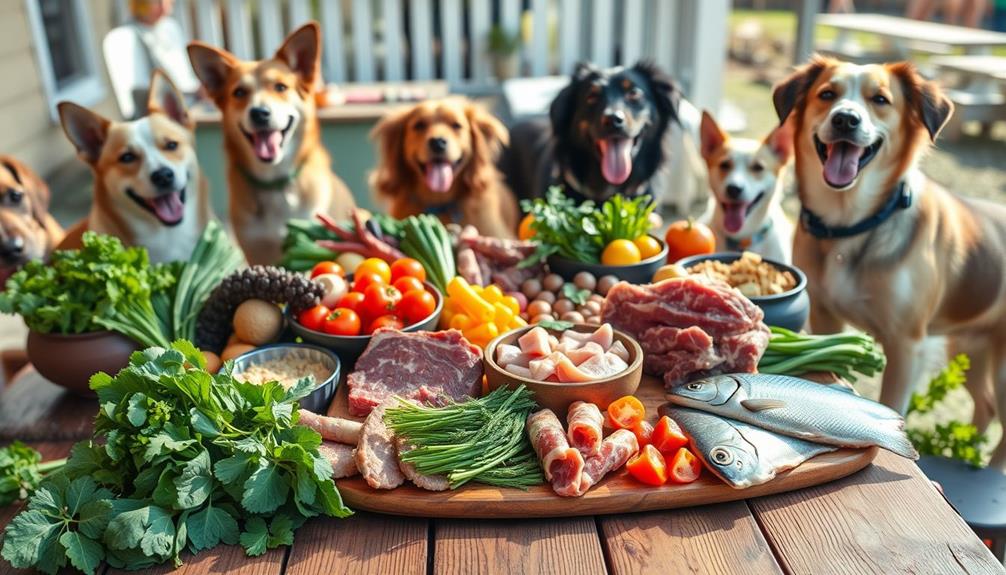
A raw food diet offers numerous benefits that can greatly enhance your dog's overall health and well-being. If you're considering this diet, here are some key benefits of a raw diet you should know:
- Improved Digestion: A raw diet leads to better nutrient absorption, resulting in smaller, firmer stools that indicate your dog is digesting food more efficiently.
- Enhanced Skin and Coat Health: By including moisture and healthy fats, dogs often enjoy a shinier coat and healthier skin, which can reduce irritation.
- Weight Management: Raw feeding helps control weight by eliminating indigestible carbohydrates typically found in kibble, making it easier for your dog to maintain a healthy weight.
- Dental Health: The natural enzymes present in raw food promote better dental hygiene, reducing plaque and tartar buildup through natural chewing.
Even incorporating just 25% raw food into your dog's diet can yield noticeable benefits, like fewer allergy symptoms and improved overall comfort.
Choosing Quality Raw Food
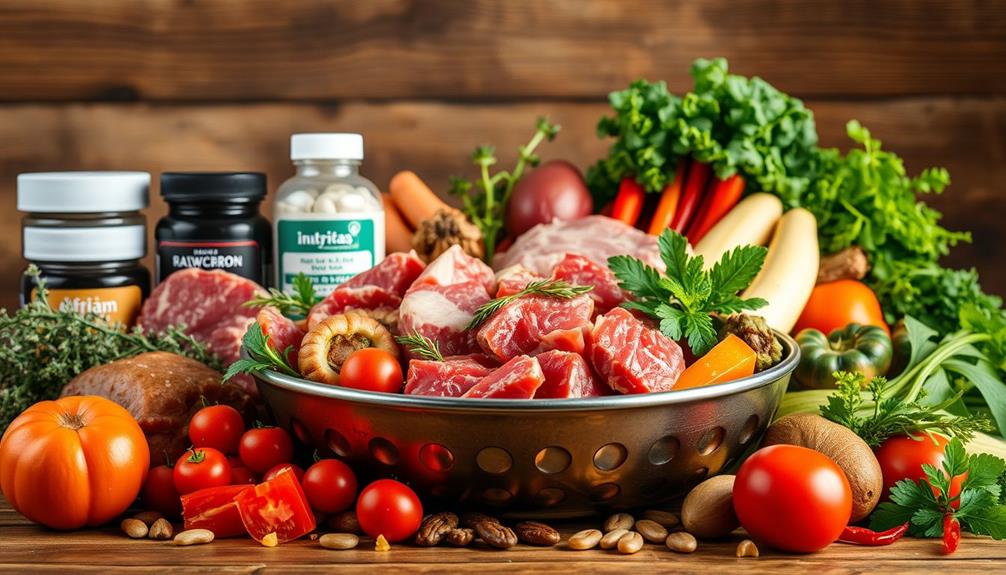
Choosing quality raw food for your dog is vital to guarantee they receive the right nutrients for peak health. Start by confirming the raw dog food you select contains a balanced mix of muscle meat, organ meat, and finely ground bone. This combination meets the nutritional needs for your dog's life stage and promotes ideal health.
Ingredient quality is critical, so look for brands that use USDA-certified, human-grade components. Reputable brands prioritize safety and nutritional value by sourcing high-quality ingredients. Investigate their quality control measures, as these practices secure consistency and safety in their products, which can greatly impact your dog's well-being.
Avoid raw food that contains fillers, preservatives, or artificial additives; these can undermine the integrity of your dog's diet. Instead, focus on brands that emphasize transparency in sourcing and food preparation methods.
This transparency builds trust and gives you confidence in the raw dog food you choose. By prioritizing these factors, you're setting your dog up for a healthier, more vibrant life.
Frequently Asked Questions
How Many Ounces of Raw Food Should I Feed My Dog?
To determine how many ounces of raw food to feed your dog, calculate 2-3% of their body weight. Active dogs may need more, while smaller dogs require a higher percentage for proper nutrition.
How Many Ounces of Fresh Dog Food Should I Feed My Dog?
To determine how many ounces of fresh dog food to feed your dog, calculate 2-3% of their ideal body weight. Adjust portions based on activity level and monitor their body condition regularly.
How Much Raw Meat Should I Feed My 50 Pound Dog?
Imagine feeding your dog a hearty steak dinner. For your 50-pound pup, you should serve about 1 to 1.5 pounds of raw meat daily, roughly translating to 16 to 24 ounces split between two meals.
How Much Does 1 Cup of Raw Dog Food Weigh?
One cup of raw dog food typically weighs between 8 to 10 ounces. It varies due to density and moisture content, so using a kitchen scale is best for accurate measurement tailored to your dog's needs.
Conclusion
In summary, feeding your dog the right amount of raw food guarantees they thrive like a well-tuned engine. By considering their weight, age, and activity level, you can tailor their diet to meet their unique needs. Remember, shifting slowly is key, and using a raw food calculator can simplify your journey. With the right quality ingredients and proper portions, you'll be setting your furry friend up for a healthier, happier life.

